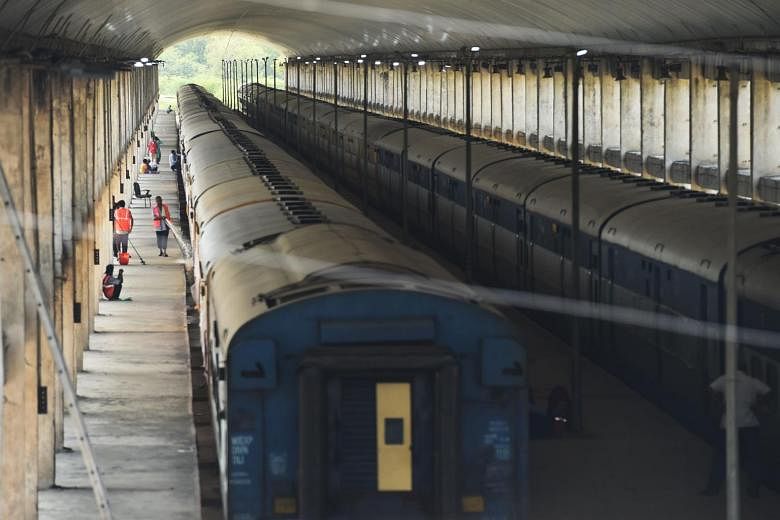NEW DELHI - Ever since it was nationalised in 1951, the colossal network of the Indian Railways (IR) has remained a near-total government monopoly.
It is one that spans over 67,000km, employs a workforce of more than 1.2 million and ferries around 8.4 billion passengers annually.
Its influence is writ so large on the country that, until 2016, it even had a dedicated budget for itself that was presented in Parliament ahead of the national budget.
But in a bid to shore up its finances, the government has now decided to lower a drawbridge to allow private operators into this impregnable fortress that so far has restricted passenger rail services only to the government.
The Ministry of Railways on July 1 invited initial bids from private players to operate 151 passenger trains on 109 routes that cover clusters around some of India's key cities.
Bids are expected to be finalised by April next year and the new trains will be made operational by April 2023.
The operators will be given licences for 35 years and have to share part of their revenue with IR.
The move is an attempt by the cash-strapped organisation to generate private investment of around 300 billion rupees (S$5.55 billion) and offer better services to passengers who can pay the higher fares expected on these premium trains that will run on IR's lines and use its other infrastructure facilities.
The private operators will be responsible for procuring, operating and maintaining the trains.
The IR's plan is also aimed at reducing a supply deficit in its services, which ranges from 8 per cent to around 13 per cent depending on the time of the year.
IR officials have said that these 151 private trains will run in addition to 13,500-plus passenger trains it runs daily. The railways expects its ridership to go up to 13 billion passengers annually by 2030 and to 18 billion by 2040.
Advocates for reform have welcomed the decision by the railways.
In a July 7 paper, Indian ratings agency Acuité Ratings and Research Limited (ARRL) said the move will improve the IR's operational efficiency with additional cash flow from private operators reducing the burden on government to provide budgetary support to the railways, which has an average operating surplus of only 2 per cent.
According to the paper, the partnership with private operators will also help the IR allocate more funds to upgrade its ageing infrastructure, such as rail tracks, signal systems, and bridges, and also encourage new private sector as well as foreign investment in the railroad segment.
"If it is managed well, it is a great opportunity for the railways to turn itself around," said Mr Suman Chowdhury, the chief analytical officer at ARRL.
Many foreign firms such as Bombardier from Canada and the French multinational company Alstom currently manufacture railway vehicles in India and it is expected they could form joint ventures with other interested firms to run these services.
The bid document requires a majority of the trains to be made in India and restricts the provision of guards and engine drivers to the IR.
Mr Chowdhury told The Straits Times many players will be drawn by the offer with an eye on long-term prospects and the desire to have the advantage of being an early mover. "It is expected that more routes will be given out if this plan works well."
"So, people will invest not just because of these 109 routes but because it is a beginning and with the hope of more opportunities later on," he added.
But the move has not been without controversy, with many worried about the impact growing privatisation of the railways could have on services used by poor and suburban passengers who account for the vast majority of IR's users.
The railways earns an average of just around 44 paise (S$0.008) per passenger per kilometre - an indication of how low non-air-conditioned train tickets are priced to keep them within the reach of the poorer masses. The low revenue from passengers is compensated by higher earnings from its freight services.
While the railways have defended the move as a way to bring in additional funds to improve its overall services, the revenue generated for the IR from this arrangement could be modest.
This is because private firms will have a limited margin to charge more for their services than what the IR currently does for its higher-end services.
Any such move will put them in direct competition with India's budget airlines that, at times, have offered tickets cheaper than those on air-conditioned trains.
The plan has also prompted criticism for not asking private players to develop the infrastructure required to run these additional trains and letting them instead benefit from a set-up that has been developed over the years using taxpayers' money.
Mr Dinesh Trivedi, an opposition leader from the All India Trinamool Congress and a former federal minister of railways, told ST the private players under the proposed plan will focus simply on delivering luxury services on a fancy coach.
"The private sector will not invest in tracks, stations, signalling systems. I would have appreciated it if the private sector was first asked to build the infrastructure they are going to use," he said. "That is where investment is really required."
Mr Trivedi likened the revenue that will be generated for the IR from this arrangement as a "drop in the ocean of investment" required to improve railway infrastructure.
He emphasised that putting these additional trains on the overburdened tracks and signalling systems will also cause operational inefficiencies such as delays.
"This is ultimately going to build two Indias on our tracks - one for the poor and the other for the rich - and further divide the Indian Railways' services," he added.


